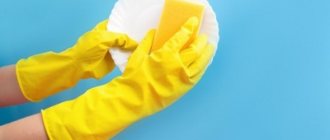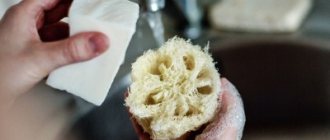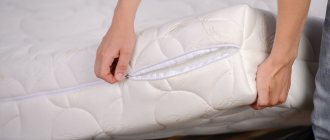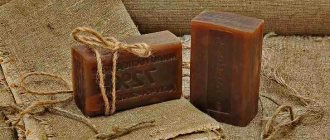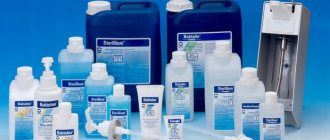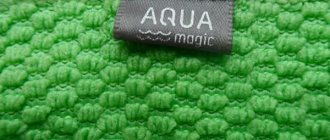What does it consist of?
The most common material for cleaning sponges is polyurethane foam or, in other words, foam rubber, which is 85% air. The reverse side of the product is represented by fiber - a material made of high-strength fibers. In addition to foam rubber and fiber, various additives are often added to the product material, which help to increase the wear resistance of foam rubber sponges. In addition, the washcloth can be made from stainless steel shavings, plastic, microfiber, bamboo and melamine.
Quality cellulose sponges contain viscose or natural wood fibers. Antibacterial components are also added to some high-quality washcloths.
Production
Sponges are produced industrially, using special machines and additional equipment. The quality of the sponge depends on compliance with the entire technological process, compliance with glue standards and the equipment itself.
The standard line includes several machines:
- Mixer for preparing the composition.
- Belt conveyor or block molds.
- Band machine (horizontal or vertical).
- Equipment for dosing components, etc.
You can watch the making of sponges in the video:
Characteristics
Depending on the material and composition used, all cleaning sponges have distinctive characteristics:
- Foam rubber. This product is suitable for daily use, and the porous structure provides a large amount of foam. Suitable for any type of dishes and detergent. They are low in cost, but the main drawback is that they quickly wear out and become unusable. In addition, foam sponges absorb odors well, take a long time to dry and cannot cope with heavy dirt.
- With an abrasive layer. This product also consists, for the most part, of foam rubber, but the reverse side is represented by a hard, fine-grained material. The hard layer is designed to remove heavy dirt. Suitable for cleaning most products, except for delicate surfaces that cannot be scratched (Teflon, plastic, ceramics, enamel).
- Metal. As a rule, such sponges are used not so often, but only when it is necessary to remove burnt fat or other complex contaminants. This product does not need to be changed frequently as it is quite durable. However, with regular use, such a sponge quickly deforms and crumbles.
- Plastic. It is considered a durable product that can cope with severe pollution. The main advantage is that it is intended for cleaning dishes made of any material. However, given the synthetic composition of such brushes, a more careful selection of the manufacturer will be required. In rare cases, it causes an allergic reaction.
- Bamboo. Bamboo washcloths are made from fibers and can handle tough stains without causing irritation or allergies. They also do not damage dishes, do not absorb odors, are easy to clean and are completely environmentally friendly. However, such products are highly expensive.
- Silicone. Such products do not absorb odors, do not accumulate bacteria, do not deform, dry quickly, are durable, resistant to high temperatures and are safe. However, this fashionable product has a number of negative characteristics: the silicone brush does not retain detergent quite well, and also slips a lot in the hand when washing dishes. In addition, it is extremely difficult to wash off heavy stains with a silicone washcloth.
- Made from microfiber. The main feature of this brush is that it can be used without using detergent. Made from environmentally friendly materials. After washing dishes, rinsing will be required, since microfiber quickly becomes unusable due to its absorbent properties. Almost powerless against heavy pollution.
- Cellulose. Products made from viscose have antibacterial properties and do not cause an allergic reaction. High-quality sponges are made from environmentally friendly materials. Cellulose brushes have a long service life. They will need to be stored on special stands where they will always be dry.
See also
TOP 30 means to remove tape marks from glass at home
Regardless of the type of cleaning product, it is recommended to choose high-quality sponges made from safe materials.
Sizes and shapes
Most often you can find rectangular devices.
Some of them have a protrusion, which is convenient for you to grasp with your fingers while washing dishes. Such sponges fit well in the hand and do not slip out, and they will help fashionistas keep their nails beautiful and well-groomed. Round or oval-shaped washcloths can be adapted specifically for cleaning dishes with a deep bottom. They are comfortable, fit well in the palm of your hand and can reach the most difficult to reach places. There are also sponges attached to the end of a plastic handle; using them, the housewife can protect her hands from the aggressive effects of water and detergents.
Rules of care
Immediately after the first use of a sponge for washing dishes, more than a billion bacteria remain on it. Moisture and food debris are an excellent environment for their active growth and reproduction. Therefore, it is extremely important to follow the rules for caring for washing products. If you use a cleaning sponge daily and regularly for household chores, it is recommended to change the product frequently - at least every two weeks. But if it has an unpleasant odor or the sponge begins to crumble, it should be immediately replaced with a new one.
A metal sponge needs to be changed every three weeks, a cellulose sponge once a month. Silicone products are changed every few months.
Very often you can find advice for processing washcloths - place the product in the microwave for a couple of minutes. However, this will not bring any benefit, since disinfection requires too high a temperature, which will simply melt the sponge.
To disinfect a dish scourer, it is recommended to use a vinegar solution. Immediately after washing the dishes, the washcloth should be thoroughly rinsed to remove any foam and put aside so that it can dry.
How to store rags in the kitchen
The kitchen has a wide variety of different rags, sponges, towels, and brushes. Things in this room require special treatment, because this is where the most germs that can harm your health are bred. Cloths in the kitchen need to be changed, dried, washed, and ventilated frequently.
Where to store cleaning rags
Some housewives store cleaning items in places of direct use, while others store them in the bathroom.
Since there is not much space in the bathroom, it is necessary to use all the available space. Many housewives leave a cloth in the sink or on it. There is no opportunity to dry, and soon the item becomes unusable. But there are sinks with recesses, which are convenient for placing sponges there.
A towel rail is used. It is attached to the wall, under the sink or other inconspicuous place. It does not spoil the appearance of the room, and is convenient for hanging products.
You can place a bucket between the toilet and the wall. Hang both floor cloths and cleaning products on it to dry. In the free space under the sink you can install cabinets, shelves, and baskets. Store dry rags there, putting everything together.
Where to store a dish sponge
The main attribute of the kitchen is the kitchen sponge. For convenience, it is placed where it is needed - in the sink or near it. But there is constant humidity in the sink and this spoils the material. More often than not, housewives keep rags near the sink.
Sponge stand
At the moment, stores have a wide range of sponge stands. Storing a sponge in such a stand is convenient and practical. After washing, water and a little detergent drain from the sponge, so it is recommended to wash the stand several times a week.
Detergent dispensers
A practical and convenient accessory. Everything is in its place here, both the detergent and the sponge. The dispenser itself helps when washing dishes, and the special sponge stand is easy to clean.
Wall soap dishes
They can be used for more than just storing soap. Such accessories look aesthetically pleasing and are convenient for everyday use for storing sponges.
Double-sided tape holders
Such holders are attached directly to the sink. The advantage is that it saves space on the countertop around the sink. Also, in this position, the sponge dries quickly, and the remaining detergent flows from it directly into the sink.
Types of sponges by material
The production includes a large number of different materials for washing dishes and kitchen surfaces. Each of the materials is good, but it is worth considering the features so as not to cause harm.
- Abrasive sponge. Hard or abrasive sponges do a good job of cleaning dirt that pure foam rubber cannot handle. They have one part foam rubber and the other abrasive. Or they are made entirely of hard material, an example of this is metal materials.
- Foam sponge. The most common use case. It has a big disadvantage in that it wears out quickly and tends to accumulate harmful bacteria. Therefore, do not be lazy and replace once a week.
- Plastic. This option is more gentle than a metal sponge. It is convenient for her to wash cups and mugs. The inconvenience is that if you apply cleaning gel to it, it can leak through the large holes that exist between the plastic fibers.
- Metal. The kind that is not suitable for washing all types of dishes. It is appropriate to use only on objects with thick metal walls. Application on Teflon coatings will damage them.
- Microfiber sponge. The basis for the production of such sponges is polyester fibers. They are characterized by: hygroscopicity and long service life. They handle dirt well and are washable.
A properly selected detergent and the type of dishwashing sponge you choose will speed up and make your work easier.
Each composition is designed for specific actions. An incorrectly chosen sponge will either not cope with its task or will seriously damage the coating.
How to protect yourself
Some recommend not changing the sponge, but disinfecting it, for example, putting it in water and heating it in the microwave (the water will boil and destroy microorganisms). But at the same time, there is an opinion that only 60% of microorganisms can be destroyed in this way.
Most experts are inclined to believe that you should not skimp on your safety. Therefore, you need to replace this kitchen item approximately once every 7 days.
You should not trust some manufacturers who deliberately extend the service life of kitchen materials to several months. When used, such sponges simply become a kind of “time bomb”.
Medical journalist Daria Sargsyan in her book “Wallpaper Killers, Poisonous Water and Tempting Stool” advises rinsing the sponge well with hot water after use. The author recommends changing the sponge every week or sooner if it starts to smell bad.
And, as you know, you can’t get by just changing the sponge. It is necessary to observe basic rules of hygiene and behavior in the kitchen when cooking. Experts advise changing napkins and kitchen towels more often, and disinfecting work surfaces and eating areas.
A few words about spices
Spices stored on kitchen shelves also need to be regularly inspected. If their expiration date has expired, then at best they will not add the necessary flavor to the prepared dish, at worst they can be harmful to health. Culinary experts from the American company Serious Eats ("Seriously about food"), as a result of research, came to the conclusion that seasonings made from mixtures of various ingredients are suitable for use for eight months (no more). The shelf life of whole, homogeneous spices is slightly longer - from 1 to 2 years. The only exceptions are some “super flavor” food additives (such as nutmeg or star anise). They retain their properties much longer. On the other hand, some powdered spices (turmeric, black pepper and ginger) almost “instantly” lose their “smell.” Therefore, it is better to purchase them in small packaged sealed packages.
What to wash dishes with instead of a sponge
You can replace foam rubber with any of the above proposed homemade options. Ordering or making your own jute washcloth will please you with the quality of washing away dirt from plates.
Different types of dishes require special care.
After changing foam rubber to this type of material, you will be surprised that detergents do not foam as much as they do on sponges. In addition, hardware stores have a large selection of washcloths. They cope with the task no worse than foam rubber, and they dry better.
If you notice that the washcloth begins to crumble or change color, throw it away immediately.
There is no universal option. It would be nice if one sponge could cope with a large number of different contaminants, did not foam too much, was environmentally friendly and did not require a large amount of detergent
When purchasing sponges, pay attention to their storage conditions and service life. By adhering to these simple rules, you take care of your health and the health of your household.
Special sponges
Metal sponges are devices that are ideal for heat-resistant cookware such as roasting pans, frying pans, skewers, cauldrons, baking sheets and ovens. Just do not wash enamel or Teflon coatings with them, as scratches may occur in which bacteria will multiply. These types include abrasive sponges.
Sponges for delicate surfaces. Often, this is a rough material that is wrapped in plastic or fabric made from soft synthetic fibers. Such a sponge will ideally clean the surface without leaving any scratches. Often these sponges have a short shelf life.
Melamine scourers. At the moment, this is the most popular option, because despite rapid wear and tear, it copes perfectly with grease on any surface. This washcloth is flexible and soft, so it does not require a huge amount of detergent, and it does not leave scratches. It is made from melamine resin. During use, the foam hits the surface, causing grease to be quickly removed. Just don’t forget that you can’t wash dishes with this type of sponge. The maximum that is allowed is aluminum pans and only from the outside.
Sponges filled with detergent - each housewife must decide for herself whether this option is suitable for her or not. Often, such washcloths are used in camping conditions, so avoid the possibility of washing dishes with which you eat with such products.
Research results
According to a National Science Foundation study (2011), the dirtiest places in the kitchen are table napkins and dish sponges. Three out of four sponges and wipes were found to be contaminated with E. coli and salmonella.
Scientists from the University of Giessen. Yu. Liebig examined sponges, the period of use of which ranged from 7 days to a month, and found 360 types of microbes in them, five of which were very dangerous.
According to another study, the number of bacteria on a week-old sponge can exceed the Earth's population by tens of times.
How often to change your dish sponge
Experts recommend replacing dishwashing sponges every week, not once a month. However, if you don't add a kitchen sponge to your weekly must-have list, you run the risk of being exposed to potentially pathogenic bacteria.
When scientists compared the microflora content of sponges that had been treated in boiling water or a microwave oven with those that were not disinfected at all, they found no difference. It turns out that disinfecting a sponge cannot completely eliminate bacteria. In addition, the sponge may deteriorate even more after washing dishes.
It should be remembered that heat treatment helps eliminate harmful microflora, but not spore cultures, from which new microorganisms appear in a short period of time. The porous structure of the washcloth, in which fat, water and organic residues accumulate, is an ideal environment for the rapid spread of bacteria.
Attempts to get rid of the bacteria contained in the sponge may further increase their numbers. Microorganisms become more resistant to external stimuli, and the rate of their reproduction and spread increases. Among the representatives of harmful microflora there are the following groups: Moraxellaosloensis, Acinetobacterjohnsonii, Chryseobacteriumhominis.
Using DNA analysis, it was possible to identify 360 types of bacteria and fungal infections that accumulate in the pores of kitchen sponges. In addition to the fact that these microorganisms cause bad odors, they are the causative agents of many serious diseases.
Most often, bacteria that enter the body due to untreated washcloths and scrubbers lead to the following problems:
- stomach upsets;
- intestinal diseases;
- diseases of the upper respiratory tract (tracheitis, pharyngitis, laryngitis);
- various infectious diseases of the digestive system;
- meningitis;
- pneumonia;
- vaginitis
The only way is to get rid of your old kitchen sponges and buy new ones. This will avoid many health problems.
How long to store
The stores offer a large selection of various cleaning materials. Let's get to know them better.
Microfiber cloths. Ideal helpers that are pleasant to the touch and absorb moisture well and remove dirt. Woven cloths are suitable for the kitchen, they are convenient for wiping dust and washing the floor. They can be washed and dried, this increases their service life to one to two years. Non-woven microfiber is universal in cleaning and is perfect for washing glass. If treated with care it will last about a month.
- A synthetic material that has proven itself to be good is latex. The product is harsh to the touch, but when wet, it absorbs moisture amazingly. This material does not wash well and gradually crumbles, so it will last no more than two months.
- Durable and easy to use natural bamboo cloths. They remove dirt and wash well. Such products can be used for up to six months.
- If you don’t like painstaking care of your equipment, then viscose rags are suitable for you. Rolled napkins are quite dense and easy to use. After one use they are thrown away.
- The biggest helpers in cleaning are sponges. They are varied and versatile. The foam base economically distributes detergents. Since the sponge not only washes, but also absorbs particles of food and dirt, bacteria multiply there quickly. It is recommended to change sponges as often as possible.
- Let's not ignore kitchen towels. The materials from which they are made (bamboo, cotton, linen) are durable, and with proper care, they complement the interior with their appearance. Items must be washed and dried frequently. It is recommended to change them every day, or at least once or twice a week, depending on the frequency of use.
How to choose the right sponge for dishes
Each housewife chooses a sponge for herself. But it is worth considering that washcloths with hard materials are strictly contraindicated for Teflon and delicate coatings. This threatens to create small cracks and scratches that will soon fill with bacteria.
In the modern world, a huge number of different sponges are produced.
Materials that are too soft will not be able to cope with tough stains. It would be appropriate to choose either a combined type of sponge (an abrasive coating on one side and foam rubber on the other), or stock up on several types of sponges. A complete set of necessary rags, sponges and other things is much more convenient than trying to wash off the stuck fat on the cauldron using foam rubber.
Cellulose sponges have a pronounced antibacterial effect.
By the way, it is worth noting another variety such as bamboo sponges. Since an allergy is an unpleasant disease that can occur to almost anything. Allergy sufferers need to select all items that cannot cause them discomfort. In addition, bamboo sponges can be safely used to clean children's dishes.
How to make a sponge with your own hands
There is nothing easier than making a sponge yourself. It consists of foam rubber, therefore, this material should be used. Since there is currently a big environmental problem, and an item made of foam rubber will take about 200 years to decompose, alternative options can be considered.
You can make your own sponge.
Among the alternative creation methods are washcloths:
- From jute;
- From a mesh for vegetables;
- From tulle
These are the main options for needlework. All of them are incredibly low cost. To knit with jute you need: jute, a hook and scissors. It can be done easily if you remember your craft lessons from school with the theme of crochet. We perform: 5 air loops, loop. We continue to knit in a circle, do not forget about double crochets, add air loops.
If you make a sponge yourself, then consider the place where it will be stored.
There is no need to tighten it tightly; you can and should even leave gaps. This technique will allow you to get a sponge that will dry quickly. Goal: a circle larger than the palm of your hand. You can add your own patterns if desired. In water, the washcloth will shrink. Don't forget to attach a loop on which you will store the washcloth at the sink. Caring for this type of sponge involves disinfecting it once every 7 days with boiling water. Additional options for use at the end of its service life can be found in the article above.
You can't make a silicone sponge yourself.
After you have bought the potatoes, you don’t have to throw away the net. Cut off the top and leave the sides alone. Fold the mesh in 4 layers. And crochet around the perimeter of the resulting square to secure the layers of the mesh and give it a beautiful decoration. Tulle appears on the bride, but not in the process of washing dishes.
Sponges made from different materials are suitable for different dishes.If you have this fabric left over, fold it into a long rectangle. Cut small strips along the entire rectangle. All the strips made must be connected to each other. Just tie with your hands. Arm yourself with a crochet hook and knit a round pattern from the created strips. Use the knitting principle as when working with jute.
Kitchen towels
For these accessories, Elizabeth Scott's recommendations are more strict. If you cook and wash dishes every day, then you also need to change your kitchen towels often. Of course, “starting up” the washing machine because of a couple of small items is not always advisable. Therefore, Elizabeth Scott herself uses disposable paper towels to wipe clean dishes and kitchen furniture surfaces. According to her, this not only saves time, but also helps maintain hygiene at an appropriate level.
Only on a soft spot: Russian Domostroy forbade punishing children in any other way
Seven daily habits of happy people
“Olga” from the series of the same name: the tragic fate of actress Yana Troyanova
Where to store rags
If you have enough space in your home and a closet, this is a great place to store your equipment. If there is no such room, then you can use a niche in the toilet or bathroom. You can attach shelves, hooks, slats, clips in it and lay out and hang cleaning cloths on them. The main thing is that the room is dry, lit and ventilated.
If there is no separate place, then you can store sponges, rags, towels in the room where they are needed. To do this, you can use a variety of devices that can be placed on a surface, hung on a wall, or attached to cabinet doors.
Many housewives use towel dryers or heating radiators for convenience. The most popular places for this are the kitchen or bathroom.
Notes[edit | edit code]
- ↑ Ozhegov S.I., Shvedova N.Yu.
Uklyuchina // Explanatory dictionary of the Russian language / Russian Academy of Sciences. Institute of Russian Language named after V.V. Vinogradov. — 4th ed., add. - M.: Azbukovnik, 1997. - ↑ Efremova T. F.
Gubka // Modern explanatory dictionary of the Russian language: In 3 volumes. - M.: AST, Astrel, Harvest, 2006. - ISBN 5-17-029521-9, ISBN 5-17-013734-6, ISBN 5-271-12339-1, ISBN 5-271-12338-3, ISBN 985-13-4715-9. - ↑ Yu. Dobrynya.
Sponges in our house // Biology for every educated person. - AST, 2022. - P. 131. - ↑ Species // Sponges: world production and markets (English). fao.org
. Food and Agriculture Organization of the United Nations (October 1990). Access date: July 24, 2022. - ↑ Sea sponges (undefined)
. Date accessed: November 27, 2022. - ↑ Global Sponge Market 2022 (unspecified)
. Date accessed: November 27, 2022. - ↑ N.S.
Alekseev. Merchandising of household goods. - Economics, 1977. - T. I. - P. 177, 211. - ↑ SanPiN 1163-74 Sanitary rules for the design and maintenance of beauty parlors in public utility and consumer services institutions.
- ↑ Reducing bacteria in household sponges – ProQuest (English). search.proquest.com
18-22. Denver: Journal of Environmental Health; Vol. 62, Iss. 1 (Jul/Aug 1999). Access date: July 24, 2022. - ↑ Klein, Joanna
We Need to Talk Some More About Your Dirty Sponges.
The New York Times
(11 August 2017). Access date: July 24, 2022. - ↑ Klein, Joanna
Cleaning a Dirty Sponge Only Helps Its Worst Bacteria, Study Says.
The New York Times
(4 August 2017). Access date: July 24, 2022. - ↑ Microbiological Safety of Kitchen Sponges Used in Food Establishments
- ↑ How often to replace sponges, which have more bacteria than toilets - Business Insider
- ↑ When Should You Throw Out Your Sponge? | MyRecipes
- ↑ International trade // Sponges: world production and markets (English). fao.org
. Food and Agriculture Organization of the United Nations (October 1990). Access date: July 24, 2022.

